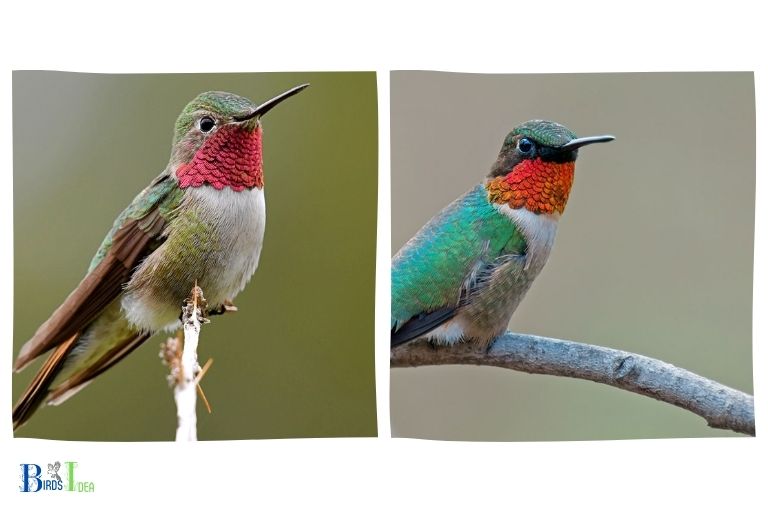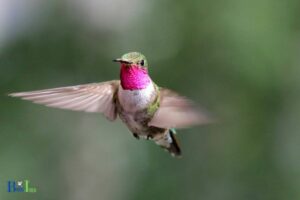Broad Tailed Hummingbird Vs Ruby Throated Hummingbird!
The Broad-tailed Hummingbird and the Ruby-throated Hummingbird are two popular species of hummingbirds.
They both have iridescent feathers and small beaks, but there are some differences between them.
The Broad-tailed Hummingbird is larger than the Ruby-throated Hummingbird, while the Ruby-throated is more widespread and migratory.
Both species feed primarily on nectar, however the Broad-tailed Hummingbird includes insects in its diet.
While both the Broad-tailed Hummingbird and the Ruby-throated Hummingbird are charming and captivating, their distinct features and behavior can help distinguish one from the other.
Despite their differences, they share common attributes such as their impressive hovering ability and penchant for nectar, making them
Comparison of the Broad-tailed Hummingbird and Ruby-throated Hummingbird
| Characteristic | Broad-tailed Hummingbird (Selasphorus platycercus) | Ruby-throated Hummingbird (Archilochus colubris) |
|---|---|---|
| Geographic Range | Western North America (Rocky Mountains, SW USA) | Eastern North America (Eastern USA, E. Canada) |
| Size | 3.5 – 4 inches (9-10 cm) | 3 – 3.5 inches (7-9 cm) |
| Plumage (Males) | Iridescent green back, rose-red throat | Iridescent green back, ruby-red throat |
| Plumage (Females) | Duller green with speckled throat | Duller green with white throat |
| Tail Feathers | Broad, square-ended tail feathers | Slightly notched, pointed tail feathers |
| Migration | Some migrate south for the winter | Migrates to Central America for the winter |
| Vocalization | High-pitched trilling sounds | Rapid chirps and squeaks |
| Feeding Habits | Nectar, insects, spiders | Nectar, insects, spiders |
| Nesting Habits | Cup-shaped nests in trees and shrubs | Cup-shaped nests in trees and shrubs |
| Primary Range | Western US, mountainous areas | Eastern US, southeastern Canada |

Exploring main differences between Broad Tailed Hummingbird Vs Ruby Throated Hummingbird

Physical Characteristics of the Broad-tailed Hummingbird and Ruby-throated Hummingbird
The Broad-tailed Hummingbird and Ruby-throated Hummingbird are both small, brightly colored hummingbirds found in North America. The two species have several distinguishing physical characteristics.

Broad-tailed Hummingbird:
- Greenish-gray back and wings
- Dull red throat (gorget)
- White tips on tail feathers
- White fringes on its outer tail feathers
- Long and broad, rose-colored bill
Ruby-throated Hummingbird:
- Green back and wings
- Red throat
- Red tail feathers with white tips
- Short and slender bill
The Broad-tailed Hummingbird also has an iridescent throat patch, which is absent in the Ruby-throated Hummingbird.
Furthermore, the Broad-tailed Hummingbird is larger than the Ruby-throated Hummingbird.
On average, the Broad-tailed Hummingbird measures 3.7 inches in length, while the Ruby-throated Hummingbird measures 3.1 inches.
“The wondrous beauty of hummingbirds has the power to captivate and captivate us”
birdsidea
Distribution of the Broad-tailed Hummingbird and Ruby-throated Hummingbird
The Broad-tailed Hummingbird and Ruby-throated Hummingbird are two species of hummingbirds that coexist in North America.
The Broad-tailed Hummingbird can be found in the western United States, while the Ruby-throated Hummingbird is common in the eastern part of the continent.

Distribution:
- Broad-tailed Hummingbird: lives in the southwestern United States and Mexico, as well as some regions of Central America. It migrates to the western United States in the summer.
- Ruby-throated Hummingbird: lives in the eastern United States and a small part of Canada in the summer and migrates to the Caribbean and northern Central America in the winter.
Both species prefer to live in temperate open spaces.
The Broad-tailed Hummingbird prefers open woodlands and mountain meadows, while the Ruby-throated Hummingbird prefers more open habitats in lowland areas.
Both species are common and can be seen in many parks and gardens.
Feeding Habits of the Broad-tailed Hummingbird and Ruby-throated Hummingbird
The Broad-tailed Hummingbird and the Ruby-throated Hummingbird are two species of hummingbird found in North America. Both birds have similar diets, but there are some key differences in their feeding habits.
The Broad-tailed Hummingbird primarily feeds on nectar from flowers, but they also supplement their diet with small insects, spiders and sap from trees.

They are most active during the day, and they will often visit the same flowers multiple times throughout the day.
The Ruby-throated Hummingbird also feeds primarily on nectar, but they also eat small insects, spiders and sap.
Unlike the Broad-tailed Hummingbird, the Ruby-throated Hummingbird is more active during the night and is less likely to revisit flowers multiple times.
Both species of hummingbird have similar diets, but the Broad-tailed Hummingbird is more active during the day and is more likely to revisit flowers multiple times throughout the day.
Nest Building Behaviors of the Broad-tailed Hummingbird and Ruby-throated Hummingbird
The Broad-tailed Hummingbird (Selasphorus platycercus) and the Ruby-throated Hummingbird (Archilochus colubris) are two species of hummingbirds that live in North America.
Both species are small, colorful birds with long, slender bills and long wings adapted for hovering and swift flight. They are also both well-known for their nest-building activities.

Nest building behaviors of the two species differ in several ways. The Broad-tailed Hummingbird typically builds its nests in trees, shrubs, or bushes, using spider webs, lichens, and mosses to bind the nest together.
The Ruby-throated Hummingbird, however, typically builds its nests on the ground, using grasses, plant fibers, and mosses to secure the nest.
Both species of hummingbirds also make use of cavities or crevices while building their nests.
The Ruby-throated Hummingbird typically uses existing cavities, such as old woodpecker holes, while the Broad-tailed Hummingbird usually builds a nest in a cavity that it creates itself.
Here are some differences in nest building behaviors between the two species:
Broad-tailed Hummingbird:
- Builds nests in trees, shrubs, or bushes
- Uses spider webs, lichens, and mosses to bind the nest together
- Typically builds nests in a cavity it creates itself
Ruby-throated Hummingbird:
- Builds nests on the ground
- Uses grasses, plant fibers, and mosses to secure the nest
- Typically uses existing cavities, such as old woodpecker holes
Behavioral Differences between the Broad-tailed Hummingbird and Ruby-throated Hummingbird
The two most commonly seen hummingbirds in North America are the broad-tailed hummingbird (Selasphorus platycercus) and the ruby-throated hummingbird (Archilochus colubris).
Both of these species have similar physical characteristics, but there are a few behavioral differences that set them apart.

Broad-tailed Hummingbird:
- Have a tendency to hover in place while feeding
- Live in the western and southwestern United States
- Often feed in large groups
- Generally more aggressive when defending a food source
Ruby-throated Hummingbird:
- Are more likely to dart from flower to flower while feeding
- Live in the eastern and central United States
- Feed in smaller groups or alone
- Generally less aggressive when defending a food source
These behavioral differences can be seen in the way these two species interact with their environment.
The broad-tailed hummingbird is more likely to hover in place while the ruby-throated hummingbird is more likely to dart from flower to flower.
The broad-tailed hummingbird is also more aggressive when defending a food source. These differences have been observed throughout the range of both species.
Other Interesting Facts about the Broad-tailed Hummingbird and Ruby-throated Hummingbird
Broad-tailed Hummingbird and Ruby-throated Hummingbird are two species of hummingbirds found in North America.
Here are some fascinating facts about them:
- The Broad-tailed Hummingbird is slightly larger than the Ruby-throated Hummingbird and has a more prominent tail. It has a distinctive trill-like call that is loud and easily heard.
- The Ruby-throated Hummingbird is the most commonly seen species in North America. It has a call that is high-pitched and often sounds like a squeak.
- The Broad-tailed Hummingbird can hover and fly backward, while the Ruby-throated Hummingbird can only hover.
- Both species migrate south for the winter, with the Ruby-throated Hummingbird flying all the way to Central America while the Broad-tailed Hummingbird migrates to Mexico.
- The Broad-tailed Hummingbird feeds on nectar from flowers and consumes an impressive amount of food each day, while the Ruby-throated Hummingbird feeds on a variety of insects and spiders in addition to nectar.
- Both species are attracted to feeders and will often return to the same feeder year after year.
These two species of hummingbirds provide a beautiful display of nature that is a delight to behold.
Conclusion
Comparing the broad-tailed hummingbird and the ruby-throated hummingbird, one can see that there are several differences between these two species.
These include size, distribution, diet, and behavior. While both are wonderful creatures, it is important to recognize and appreciate the unique features that make these two species both unique and special.






